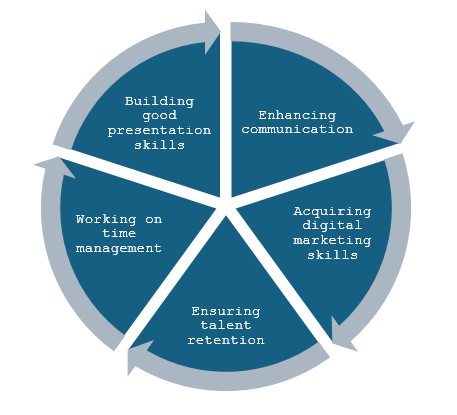Importance of Corporate Training

Corporate training nurtures skill enhancement and talent management of the employees. It strategically helps in narrowing skill gaps and aligning with latest market trends. The trainings often focus on acquiring new skills, encouraging leadership skills, informing about digital enhancement and nuances and sharing knowledge and useful information that would employees perform better in the organisation. Corporate trainings include live or physical instructor-led sessions with real-life scenarios and examples.
Investing in quality corporate training is necessary for any organisation’s development and ensuring that the organisation can meet up to the expectations and requirements of a competitive industry. Some aspects of such training are empowering employees to be customer-centric, enhancing their soft skills, becoming technically savvy, and developing their leadership skills.
Corporate trainings are conducted to cover essential business practices, latest industry trends and digital marketing, project management and information technology topics.
Some benefits of corporate trainings are:

The reason for conducting corporate trainings vary for different organisations depending on their size, agenda, need and other aspects that define their mainstream business. However, the most common aspects of corporate trainings can be summed up as follows:
- Identifying and addressing skill – Analysing the skill gaps in one’s employees is important for any business development. It is important to correctly identify not only the gaps but also the means to bridge these skill gaps. Managing and successfully closing skills gaps encourage employees to work better and lead to overall organisational growth, thus eventually leading to higher retention rates.
- Identifying the correct and appropriate courses – When choosing a training course, one must take into consideration the market trends, latest skills acquired by competitors, recent technological advances, leadership goals and developing the business digitally.
- Assessing Training Providers – After narrowing down the training requirements and agenda, you need to choose training providers who are exerts in their field. While selecting training providers, one needs to evaluate the trainers based on years of experience, the variety of topics extended and their abiloity to provide valid, real-life corporate client case studies.
Eventually, one should ensure that while providing corporate training, the most effective ones are those that are tailored to meet the collective corporate goals and are adaptive to market trends. Corporate trainings are conducted to combine best practices and relevance to the current job roles while ensuring a deep impact on the productivity of employees.




